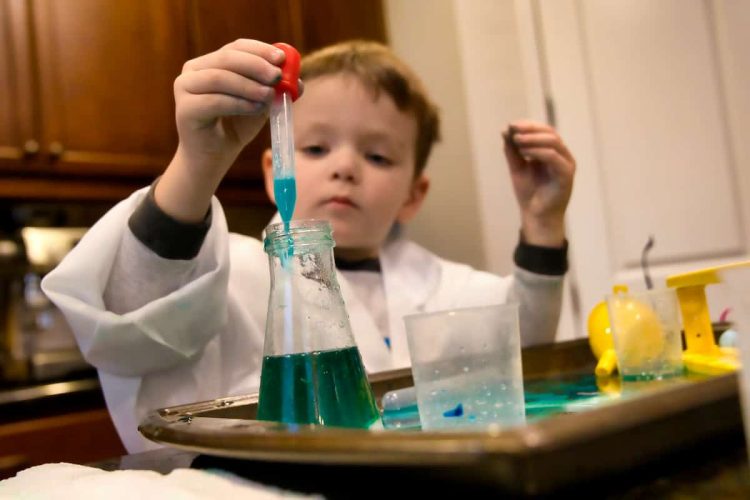Are you looking for fun and effective hands-on science activities to engage your young learners? We’ve created a list of eight fun and effective hands-on science activities for kids that you can try yourself.
Studies show that students retain 75% of what they learn when they can practice what they learn. So, go ahead and test that theory by trying out these hands-on activities.
1. Dancing Raisins
This activity can spark your child’s curiosity. It’s simple yet fascinating, and it amazes children while laying the foundation for understanding buoyancy. As homeschooling parents, you’ll love the ease and effectiveness of this hands-on activity.
Instructions
- Fill a clear glass 3/4 full with transparent soda (like Sprite).
- Gently drop a few raisins into the soda.
- Sit back and observe as the raisins dance their way up and down.
2. Homemade Lava Lamp
Do you remember the psychedelic glow of lava lamps? You can now recreate the magic at home with a simple twist on chemistry and density. Creating a homemade lava lamp is visually captivating and an excellent conversation starter on liquid densities and chemical reactions— perfect for those successful online classes.
Instructions:
- Fill a clear bottle 3/4 full with vegetable oil.
- Add water until the bottle is nearly full, leaving a small gap at the top.
- Squeeze in a few drops of your favorite food coloring.
- Drop an effervescent tablet (like Alka-Seltzer) into the bottle and watch the colorful bubbles rise!
3. Crystal Snowflakes
You can’t easily replicate many wonders of science, but growing your own crystals isn’t one of those things. Allow children to explore the mesmerizing world of crystal formation by letting them create their own crystal snowflakes. It will feel like winter magic any time of the year.
Instructions
- Shape a pipe cleaner into a snowflake form.
- Attach a string and hang it inside a jar.
- Dissolve borax powder in boiling water and pour it into the jar.
- Let it sit overnight. By morning, you’ll have a sparkling crystal snowflake!
4. Magnetic Slime
Teach your kids about magnetism with gooey fun. This interactive experiment allows kids to witness the fascinating tug and pull of magnetic fields and make the unseen visible.
Instructions
- Mix 1/4 cup of white glue with 1/4 cup of water in a bowl.
- Add some iron oxide powder and mix well.
- Slowly stir in liquid starch until the mixture achieves a slimy consistency.
- Place a magnet near the slime and watch the magnetic attraction in action!
5. Invisible Ink
Create spy-like secret messages with this exciting invisible ink experiment. Using simple chemistry, kids can send and reveal hidden messages and build a love for science and mystery. It’s an adventure in a bottle, perfect for every little detective out there.
Instructions
- Squeeze lemon juice into a small bowl.
- Dip a cotton swab or fine paintbrush into the juice and write a message on a piece of white paper.
- Allow the message to dry completely.
- To reveal the secret message, gently heat the paper using a light bulb or a hairdryer.
6. Egg in a Bottle
The “Egg in a Bottle” experiment is a classic demonstration of air pressure in action. As the air inside the bottle cools and contracts, it creates a vacuum effect, pulling the egg inside. It’s a whimsical way to show kids the power and effects of atmospheric pressure.
Instructions:
- Place a peeled hard-boiled egg on the mouth of a glass bottle (the egg should be larger than the opening).
- Light a paper strip on fire and quickly drop it into the bottle.
- Place the egg back on top immediately. The egg will be sucked into the bottle as the flame goes out.
7. Growing Gummy Bears
If you never thought candy could be educational, you haven’t tried this lesson. This experiment allows children to explore the osmosis process using colorful, sugary gummy bears. Kids can witness firsthand how water moves through semi-permeable materials as they swell in size. Plus, it’s a sweet way to learn!
Instructions:
- Place a gummy bear in a cup filled with water.
- Leave it to soak overnight.
- Observe the gummy bear the next day, noting the increase in size due to osmosis.
8. DIY Sundial
Let’s take a trip back to when clocks weren’t digital and shadows told the time. Creating a DIY sundial is a sunny blend of history, astronomy, and practical science. It encourages kids to notice the sun’s movement and understand the Earth’s rotation—a timeless classic for homeschooling parents.
Instructions:
- Place a straight stick vertically into the ground or in a lump of playdough on a flat surface.
- Throughout the day, mark the shadow’s tip every hour.
- Label each shadow mark with the corresponding time. Voila, you have a sundial!
Simple Activities Today, Advanced Learning Tomorrow
As we immerse our kids in the wonders of hands-on science, we nurture their innate curiosity and lay the foundation for rigorous analytical thinking. This foundational knowledge and inquiry-based learning can benefit fields as advanced as an online MFA.
Whether it’s understanding the simple dance of raisins in a soda or the more complex notions of atmospheric pressure with the “Egg in a Bottle” experiment, every lesson counts. It’s never too early to ignite the spark of learning.

